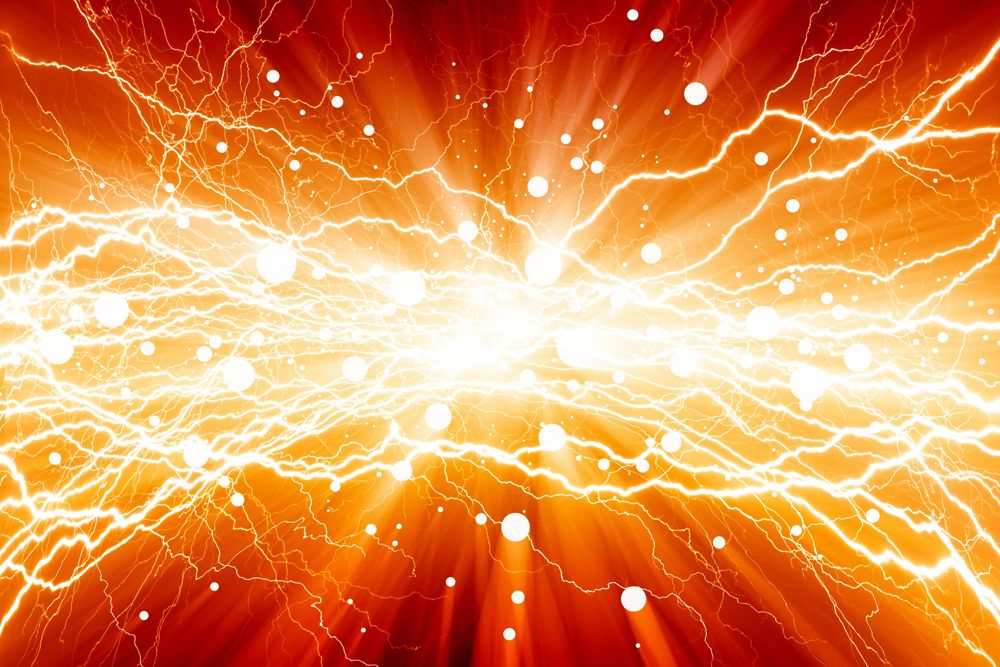What Is Electric Charge?

Most electric charge is carried by the electrons and protons within an atom. Electrons are said to carry negative charge, while protons are said to carry positive charge, although these labels are completely arbitrary (more on that later). Protons and electrons attract each other, the archetype of the cliché "opposites attract," according to the University of Georgia’s website, HyperPhysics. Conversely, two protons repel each other, as do two electrons.
Protons and electrons create electric fields, which exert a force called the Coulomb force, which radiates outward in all directions. According to Serif Uran, a professor of physics at Pittsburg State University, the electric field radiates outward from a charged particle similarly to how light radiates outward from a light bulb. Just as with the brightness of the light, the strength of the electric field decreases as the square of the distance from the source (1/r2). If you move twice as far away, the strength of the field decreases to one-fourth, and if you move three times as far away, the field decreases to one-ninth.
Because protons are generally confined to the nuclei imbedded inside atoms, they are not nearly as free to move as are electrons. Therefore, when we talk about electric charge, we nearly always mean a surplus or deficit of electrons. When an imbalance of charges exists, and electrons are able to flow, an electric current is created.
A localized and persistent deficit or surplus of electrons in an object causes static electricity. Current can take the form a sudden discharge of static electricity such as a lightning bolt or the spark between your finger and a grounded light switch plate; the steady flow of direct current (DC) from a battery or solar cell; or an oscillating current such as that from an alternating-current (AC) generator, a radio transmitter, or an audio amplifier.
Electric universe
We are usually unaware of electric charge because most objects contain equal amounts of positive and negative charge that effectively neutralize each other, according to Michael Dubson, a professor of physics at the University of Colorado Boulder. It is generally believed that the net charge of the universe is neutral. If the ratio of positive to negative charge were off by a factor of only 10−40, the Coulomb force would be more powerful than gravity, which would make the universe quite different from the one we observe, Dubson told Live Science. Nevertheless, some researchers, such as Michael Düren of the Justus Liebig University Giessen in Germany, have speculated on the possibility of an electrically charged universe.
Early electric research
Positive and negative values of charge were originally assigned by the American statesman and inventor Benjamin Franklin, who started studying electricity in 1742. Until then, most people thought that electrical effects were the result of mixing of two different electrical fluids, one positive and one negative. However, Franklin became convinced that there was only one single electric fluid and that objects could have excess or deficiency of this fluid. Therefore, according to the University of Arizona, he invented the terms positive and negative to designate an excess or deficiency, respectively.
The unit for measuring electric charge is the coulomb (C), named after Charles-Augustin Coulomb, an 18th-century French physicist. Coulomb developed the law that says "like charges repel; unlike charges attract." A coulomb is defined as the amount of charge transported by a current of one ampere for one second. While this sounds like a small amount, according to HyperPhysics, “Two charges of one coulomb each separated by a meter would repel each other with a force of about a million tons!” Electrical engineers often prefer to use a larger unit for charge, the ampere hour, which is equal to 3,600 C.
The Coulomb force is one of the two fundamental forces that is noticeable on a macroscopic scale, the other being gravity. However, the electrical force is much, much stronger than gravity. The repulsive Coulomb force between two protons due to their charge is 4.1 × 1042 times stronger than the attractive gravitational force between them due to their mass. This is true at any distance, since the distance cancels out on both sides of the equation.
Just how big of a number is that? Comparing the magnitude of the two forces is like comparing the mass of the Earth to the mass of a single molecule of penicillin! However, gravity still dominates the universe on a large scale, because, unlike charge, it is possible to assemble large quantities of mass. Large accumulations of similarly charged particles are not possible due to their mutual repulsion and their affinity for unlike charges.
Other properties of charge
Electric charge is quantized, meaning that it occurs in discrete units. Protons and electrons carry charges of ±1.602 × 10−19 C. Every accumulation of charge is an even multiple of this number, and fractional charges cannot exist. Quantum chromodynamics (QCD) states that protons and neutrons are each composed of three quarks with charges of +2/3 or −1/3 of the unit proton charge, and two of one and one of the other combine to form particles with charges of zero or +1 unit charge.
However, these particles cannot exist separately. Whenever you try to split a proton or neutron into its constituent quarks, it takes so much energy to do so, the energy is converted into matter in accordance with Einstein’s famous equation E = mc2, and instead of a single quark, you end up with a neutrally charged quark–antiquark pair, called a meson. Electrons, though, are believed to be truly fundamental, meaning they cannot be split into smaller parts.
Electric charge is a conserved quantity. That means it cannot be created or destroyed, and the net amount of electric charge in the universe is constant and unchanging. Positive and negative charges can neutralize each other, or neutral particles can split to form positively and negatively charged pairs of particles, but the net amount of charge always remains the same.
Additional resources
Sign up for the Live Science daily newsletter now
Get the world’s most fascinating discoveries delivered straight to your inbox.













